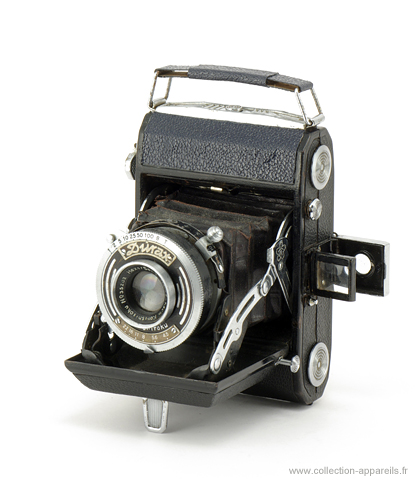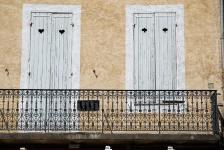|
Konica Semi Pearl |
Manufactured or assembled in Japan from (After) 1943 to (Circa) 1948.
Index of rarity in France: Rare (among non-specialized garage sales)
Inventory number: 13898
See the complete technical specifications
Chronology of cameras Konica
Le mot Semi dans le nom Semi Pearl est à rapprocher de Demi, car il s'agit d'un demi-format (4,5 x 6 cm) sur pellicule 120. Toutes les grandes marques de cette époque ont sorti un modèle Semi. Le Semi Pearl est dans la norme de cette catégorie d'appareils.
Il présente quelques particularités :
- Le déclencheur n'est pas le bouton situé au dessus du viseur, comme on pourrait s'y attendre. Il se trouve sur le rebord de l'abattant, et doit donc être manœuvré de la main gauche, au moins pour les prises de vues verticales (appareil tenu horizontalement).
- La mise au point se fait par une superbe hélicoïde commandée par le bouton annelé au dessus de l'objectif.
- Le déploiement du viseur est automatique, à l'ouverture de l'abattant.
Les variantes du Konica Semi Pearl semblent pléthoriques ; les conditions de production dans un pays détruit par la guerre expliquent cela. La datation précise de ces variantes est très difficile.
On sait (camera-wiki) que le Semi Pearl original de 1938 avait des arrêtes chromées, et deux fenêtres inactiniques au dos. Les arrêtes peintes en noir, comme ici, semblent apparaître vers 1940.
On sait aussi que la société à l'origine de Konica s'appelait Rokuo-Sha jusqu'en 1943. Notre exemplaire porte un marquage Konishiroku sous l'objectif et au dos, ce qui le date postérieur à 1943. Le marquage dorsal a la forme d'un cadre rectangulaire, avec des coins arrondis. Sur les exemplaires tardifs, le marquage a la forme d'un losange.
Notre exemplaire porte également au dos l'inscription Made in Japan, ce qui est source d'interrogation et de débats entre connaisseurs. Il semble peu problable qu'un appareil japonais en temps de guerre porte une telle inscription destinée normalement à identifier les appareils pour l'exportation. Durant la guerre, le Japon était particulièrement isolé. Toutefois, certaines personnes, se basant sur les caractéristiques du modèle affirment qu'il s'agit pourtant d'une production en temps de guerre. Peu de temps après la fin de la guerre, les USA, occupant le Japon, imposèrent que les fabrications japonaises exportées soient marquées MIOJ (Made In Occupied Japan). Cette obligation prit fin en 1949. Ne devait rester alors que le marquage "Made in Japan". L'abrogation fut plus ou moins rapide sur les marchandises.
On notera que la cuirette supérieure de cet exemplaire, en façade, n'est pas d'origine : elle devrait être estampée "Semi Pearl" dans un cadre rectangulaire. Le revêtement de la poignée avait lui aussi disparu et a été refait, un défaut qui semble récurent sur ces appareils. Certains exemplaires tardifs1 avaient à cet endroit un marquage "Made In Occupied Japan" ; la perte de cette partie du gainage n'est peut-être pas accidentelle.
Lors de l'occupation américaine, les appareils vendus aux GI avaient en principe une échelle des distances en pieds, mais une certaine désorganisation de la fabrication fit qu'une partie des appareils continua à être vendue avec une échelle en mètres.
Le numéro de série de l'objectif Hexar Serie I (n° 35 202), plutôt haut, rend plus crédible une fabrication d'après-guerre.
Cet exemplaire possède encore les deux fenêtres inactiniques au dos.
A partir de 1948, le modèle se stabilisera, avant d'être remplacé en 1949 par le Pearl I, équipé d'un télémètre.
1 mentionnés comme des modèles avec un seul regard inactinique.


History
1873 Establishment of the Konishi-ya company. Initial implementation of photographic and lithographic materials.
1876 Relocation to Tokyo. The company is renamed Konishi Honten.
1882 Three factories are established in Tokyo, producing photographic equipment, coated paper, and lithography equipment.
1897 Introduction of the first cinematographic cameras in Japan, enabling the production of Japanese films.
1902 Establishment of a new factory in Tokyo dedicated to the production of photographic plates and papers. This factory is considered the birthplace of the Japanese photographic industry.
1903 The first photosensitive paper produced in Japan, Sakura Hakkin type paper, and the Cherry camera are introduced to the market.
1909 Opening of the Osaka Agency. Introduction of the LiIy camera.
1919 Consolidation of factories in Tokyo, forming Japan's first modern photographic organization.
1921 This organization becomes the Konishiroku Honten Company (Honten = headquarters).
1925 Introduction of Pearlette cameras.
1929 Launch of Sakura films (Sakura = Japanese cherry blossom).
1933 Expansion of the headquarters.
1936 The company becomes Konishiroku Co., Ltd. Opening of an agency in Hino, and relocation of the Sensitive Materials Production Division.
1938 Introduction of the Semipearl camera.
1940 Announcement of the production of the first Japanese color film, Sakura Natural Color Film.
1943 The company adopts its current name, Konishiroku Photo Industry Co., Ltd., and the factories are renamed.
1944 Merger with Showa Photo Industries Co., Ltd., adding the Odawara and Koyama factories to the company.
1945 End of the war, leading to a chaotic economic situation. A major reorganization is undertaken to enable the company to survive this tumultuous period.
1948 Sale of the first KONICA-branded cameras and resumption of exports.
1963 Inauguration of the large factory for the production of photographic equipment.
1967 Introduction of the world's great innovation, the SAKURACOLOR N-100, along with the world's first automatic reflex, the KONICA AUTO-REFLEX.
1968 The first automatic reflex camera (EE) incorporates through-the-lens (TTL) metering: it becomes the KONICA AUTOREFLEX T. Production of the first Japanese 24 x 36 compact rangefinder camera, the KONICA C35, in the same year.
1969 Development by Konishiroku of the world's first compact holographic camera.
1970 Start of the sale of U-Bix electrostatic dry photocopying machines. Introduction of SAKURA High Resolution Plate, ultra-fine grain, high-resolution sensitive material essential for Integrated Circuit manufacturing.
1971 Introduction of the new SAKURACOLOR. Commencement of U-Bix MARK I export.
1973 Celebration of the 100th anniversary of the company. Adoption of the new logo. Departure for a new century with renewed enthusiasm.
Interesting links or bibliography :
Add a link or element of bibliography, a picture taken with this camera, a picture of box or an ads about this camera
Your photos taken with the same camera:
Cameras from Ebay France (Konica) (Uploaded each 3 hours)
 Appareil De Photo Konica 30,00 euros Finira le 04-05-2024 à 15:07:46 |  Konica C35 EFP Lens 38mm F4 Appareil photo argentique - Non Testé - Pour Pièces 1,00 euros Finira le 04-05-2024 à 16:43:13 |  Appareil photo Compact * Konica BM-S 248Z * argentique vintage 24-48 mm 27,50 euros Finira le 04-05-2024 à 16:22:14 |  APPAREIL PHOTO KONICA EF-88 non testé en l'etat 10,00 euros Finira le 06-05-2024 à 11:42:36 |








